
Any parent of tweens and teens knows that staying organized while working, running a household, and shuttling offspring to eight million activities is enough to make even the most on-top-of-it parent’s head spin. To help you keep things straight and get it all done without going bonkers, here’s a roundup of the best family organization apps for the busiest parents and kids.
Apps were chosen to address the main organization challenges that are a struggle for families. An emphasis was placed on affordability, and all family organization apps on the list allow collaboration between family members.
Best for: Simple shared and individual calendars without any frills
Platforms: iOS, Android, web
Cost: Free
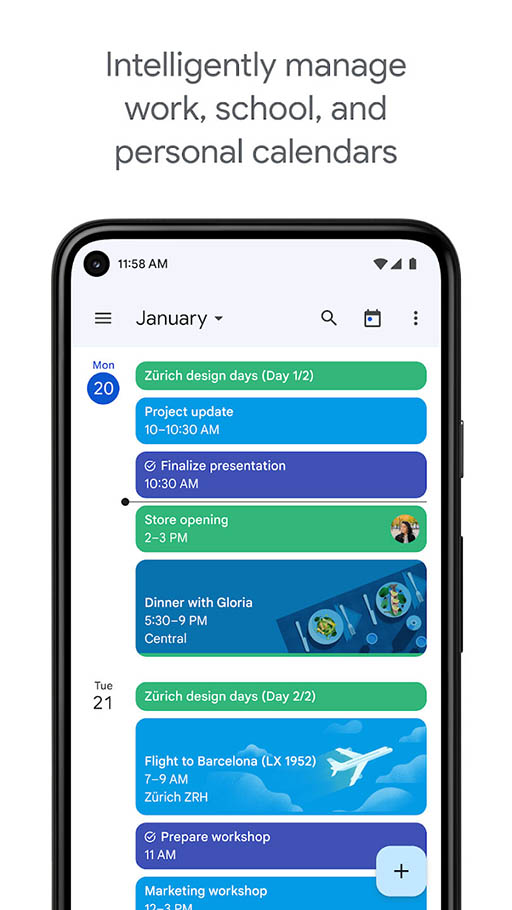
It may seem a tad obvious to suggest a Google product, but stick with me. When it comes to organization and calendaring, no one does it quite like Google. When I tell you my household runs on Google Calendar, I’m not exaggerating. It seamlessly syncs across devices and time zones and allows for multiple calendars — both individual and shared.
Google Calendar integrates with Outlook as well as the native iPhone calendar app, so you can move from work to home without missing a beat. If you’re still using a wall calendar to organize your family’s schedule, give Google Calendar a try — you can thank me later.
Best for: All-in-one calendar, task management, and to-dos
Platforms: iOS, Android, web
Cost: Free (with robust features), upgraded plans $29.99/year
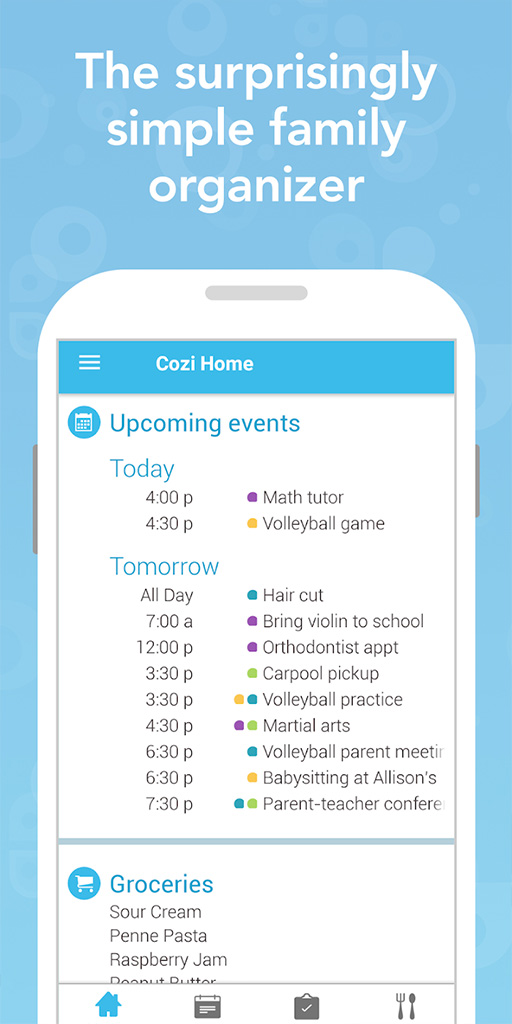
Cozi is the workhorse of organization tools. With all-in-one calendars, to-do and shopping lists, meal planning, notifications and reminders, Cozi really does it all. It even includes a journal feature where you can add pictures and memories to create an interactive, digital family scrapbook.
Cozi also integrates with other popular calendar apps such as Google, Apple, and Outlook, so you don’t have to start from scratch if you already have a scheduling system that works for your family.
Best for: Task management, shared to-do lists
Platforms: iOS, Android, web
Cost: Free, paid plans start at $4/month
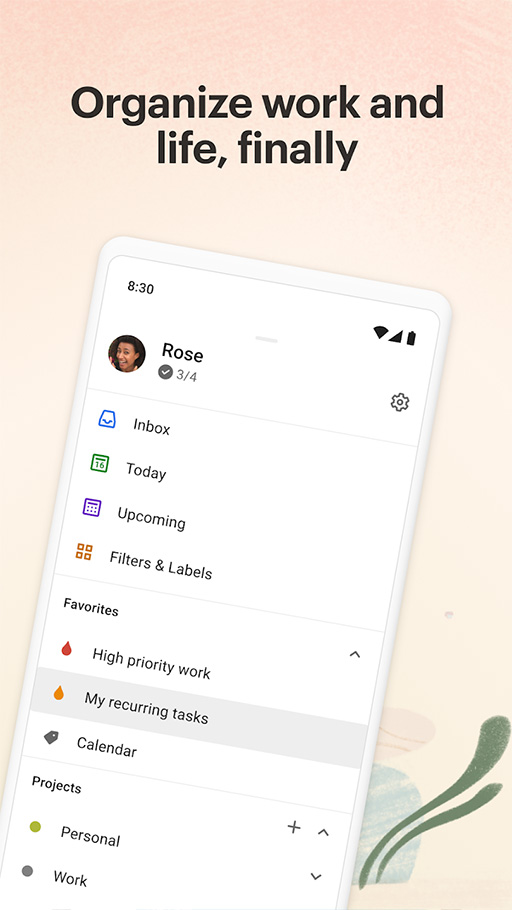
Most of the other popular task management tools are geared for businesses, meaning complicated setups and features that are better for the boardroom than the living room. Todoist is unique in that it’s designed to fit both your work and personal life.
Its easy-to-use interface allows you to create projects complete with subtasks, due dates, and reminders. You can even delegate tasks to others so you can assign extra family duties to your kids or upgrade from the home project list currently hanging on your fridge.
And if your kids (or you!) need a little extra motivation, Todoist has a fun feature where you can track your progress and earn “Karma” points.
Best for: Groceries, recipes, meal planning
Platforms: iOS, Android, Mac, PC
Cost: $4.99 mobile, $29.99 desktop
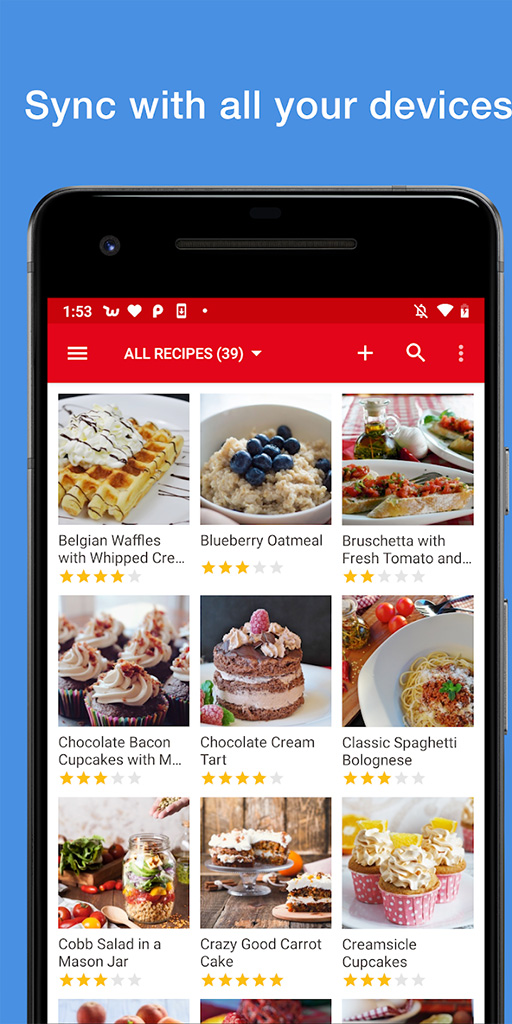
Before I compiled this list, I was already a superfan of Paprika, so it was a no-brainer to include it here. Paprika is an all-in-one meal planning, recipe management, and grocery list app to help you feed your hungry hoard and even enlist them to help.
You can load recipes directly from your favorite cooking blogs and add items onto your grocery list with the click of a button. The auto-scale feature means it’s a cinch when your kids want to invite friends over for dinner.
With auto-sync, your family can add last-minute items to the list while you’re at the store. (Although I give you full permission to claim you don’t get a signal at the store if you aren’t a fan of emergency Cheetos requests in the milk aisle.)
While it’s possible to get by with phone reminders, Post-Its, and scrawled notes on your forearm, the best organization app for families can help you and your household stay on top of everything from upcoming events to household chores. The big benefit of these apps is that they’re collaborative — because nobody should have to go it alone when it comes to organizing your household’s to-dos.

Pandemic lockdowns may be in the rearview mirror, but remote work is here to stay. For the work-from-home parents among us, summer break ushers in a new crop of officemates: our kids.To help ease the transition and keep the peace at home and work, here’s how to work from home with kids — and maintain boundaries with your family when you’re on the clock.
Set limits for how and when your kids can interrupt you during your work hours. For example, if they’re older, you might ask them to text you before entering your office. A visual signal — such as a closed door or a “Stop” sign — is a great way to let your kids know when you’re in an important meeting and they should only disturb you in case of an emergency.
If possible, give yourself a dedicated office space that’s physically separated from the rest of the house (even if just by a door or a screen). This will not only allow you to focus better, but it will also help your kids make the mental switch when you head into work.
Create a work schedule and follow it as much as possible. Knowing when to expect you back on parent duty makes it easier for your kids to be patient while you work. Post your work schedule or put it in a digital shared family calendar so everyone is on the same page.
When working from home, it can be easy to slip into always-on mode. But the more you can truly log off at the end of your workday and be present with your family, the easier it will be for your kids to respect your boundaries during working hours. It may be useful to create a simple ritual like changing your clothes or closing your office door to indicate to your kids (and yourself) when you’ve clocked out.

Taking breaks while working from home is important so you don’t end your workday burned out and grumpy with your children. Since your kids are your new office mates, include them in some of your breaks — a walk around the block together or a quick snuggle session provides a needed moment of connection so they’re less likely to seek your attention when you’re back at your desk.
Be flexible to the extent that your job allows. Shifting your schedule earlier so you can drive your kids to their activities or bringing your laptop with you to work in the car while you wait are great ways to maximize your work time while remaining present for your children.

The beauty and the curse of having tweens and teens is that they couldn’t care less about their parents when their friends are around. Encourage your kids to make plans, even if that means a hoard of preteens invading your house for the day. You might need to stock the kitchen with more snacks or put on noise-canceling headphones to shut out the squeals, but you’re way less likely to be interrupted while you work.
Yes, screen time limits are important for kids. But if you need to dole out a little extra now and again so you can meet a deadline, don’t beat yourself up. Screen time is just another tool in your arsenal — as long as you’re intentional and balance it out with plenty of other activities, your kids will be fine.
Even the best boundary-setting efforts are bound to fail now and again. If your kids are arguing outside your door making it hard to focus on your Zoom meeting, simply excuse yourself to briefly deal with it. This isn’t always possible, but honesty (and humor) go a long way, and your colleagues will likely understand — especially if they’re also parents.
Life as a work-from-home parent brings with it both joys and struggles. If you’re wondering how to work from home with kids, remember that communication, clear boundaries, and flexibility go a long way to setting you up for success for working remotely while your children are home.

Forget lemonade stands, tweens and teens these days are taking their entrepreneurial spirit well beyond a handmade sign in the front yard. From app developer to social media influencer to product creator, the possibilities are endless. If your kid is interested in using their leisure time to start their own business, here are some apps and online tools to help them on their way.
We looked for a wide variety of tools to cover multiple areas of running a business. Selected apps and websites are either geared toward kids or are known for being accessible for beginners.
Best for: Learning financial and business literacy
Platforms: Web
Cost: Free, with some paid content
Biz Kid$ is a financial literacy website for kids geared toward business and entrepreneurship based on the TV show with the same name. It’s a good starting place for learning the basics about running a business, including resources on business plans, financial skills, general entrepreneurship, and the economy.
Best for: Scheduling social media content
Platforms: iOs, Android, web
Cost: Free plan available, paid plans starting at $6/month
“Social media influencer” is now one of the most popular career goals for tweens and teens, and many entrepreneurial kids are starting young. Keeping up with the demands of daily posting on multiple platforms can be a lot, though, especially when school starts back up again. Getting ahead by scheduling posts with Buffer can help.
Best for: Drag-and-drop graphic design
Platforms: iOs, Android, web
Cost: Free plan available, paid plans start at $12.99/month
Canva is a great graphic design program for beginners. With preloaded templates and graphics, users can easily create social media content (including videos), print material, presentations, and more. While the paid plan includes a lot more photos and graphics, the free plan is still quite robust, and many items can be purchased for $1 per use.
Best for: Step-by-step business planning
Platforms: web
Cost: Plans start at $15/month
If your kiddo is serious about running a business, especially if they hope to eventually find funding, they’ll need a business plan. LivePlan is an excellent tool that can guide them through every stage of creating and maintaining a business plan, from pitching to financials to growth. If you’re looking for a free option, LivePlan offers free business plan templates at the company’s sister site, BPlans.
Best for: User-friendly invoicing for beginners
Platforms: iOS, Android, web
Cost: Free plan available, paid plans start at $24/month
It’s essential your budding entrepreneur get a handle on their business finances sooner rather than later. Unlike programs like QuickBooks, Fiverr Workspace doesn’t require a robust understanding of accounting principles or software. It can be used for everything from invoicing to time tracking, and users can accept online payments from customers.
Best for: Easy, drag-and-drop website building
Platforms: iOS, Android, web
Cost: Plans start at $16/month
For entrepreneurs in 2023, a slick website is a must. Luckily, coding skills are no longer necessary for creating a great internet presence. Wix’s drag-and-drop tools and insanely customizable options will have your kid entrepreneur up and running online in no time.
Best for: No-code app design
Platforms: iOs, Android, web
Cost: Plans start at $16/month
Is your kid long on awesome app ideas but short on actual coding skills? Of course, there’s always tools like CodeMonkey to help them learn — but in the meantime, AppyPie is a great option for designing a killer app without coding. It even includes an in-depth 10-step guide for app creation, from conception through promotion.

Whether your kid wants to figure out how to monetize their YouTube channel or start a business on the side, there are plenty of tools and apps available that can help set them up for success. But it’s important to stay involved in your kid’s entrepreneurial journey as they figure out how to safely and securely set up payments and launch a product or business. Have regular check-ins with them about their challenges and pain points so you can work through them together — and give your kid a safety net along the way.

Forget when to let your child start dating — when to let them start using social media is the new debate for modern parenting. It’s an important decision, but knowing when the time is right can be daunting. So, how young is too young to use social media? Read on for helpful tips to guide you through.
Social media is a double-edged sword. Here are some benefits and drawbacks to consider:
As you decide when to let your child use social media, consider both their age and maturity level.
How young is too young to use social media? Most social media platforms require a user to be at least 13, but not all parents abide by this. Some research indicates that upward of 50% of parents allow their preteen to use some form of social media. (Note that signing up before age 13 requires fibbing.)
On the other hand, there’s no reason you must let your child open accounts the minute they turn 13. Take into account your child’s individual circumstances and make a decision that feels right to you. If your kid struggles with their peers having social media before they do, check out this helpful guide.
When a child is ready for social media isn’t just a matter of their calendar age. Kids mature at different rates. Be honest with yourself when you consider whether your child is capable of handling the risks and responsibilities of social media.
Once you’ve decided it’s time to let your child use social media, it’s worth taking the time to approach the transition thoughtfully. Here are a few points to keep in mind:
While your child might be eager to jump in, signing up for multiple social media platforms at once could be overwhelming. Consider starting with one platform and letting your child adjust to the rules and boundaries you instill around social media use. When they’re ready, they can sign up for another platform in conversation with you.
Not sure how to set up those rules and boundaries? A digital device contract is a great way to set your child up for success and establish clear expectations when they’re ready to start using social media.
While 13 is the minimum age for most of the major social media sites, there are a few options specifically geared toward younger kids.
There are many social platforms teens may use online, but we’ve covered some of the most common apps or sites below. Use these recommendations as thought-starters if your child wants to sign up for another platform not listed here.
As your child embarks on this new phase of digital freedom, consider yourself their guide. Talk to them about digital privacy and what to share (or not) online. Your involvement will not only help keep them safe now, it will set them up for a lifetime of wise online choices.
Following your child’s accounts, regularly looking at their posts together, and using a parental monitoring app like BrightCanary are all great ways to keep an eye on their social media use and help keep them safe.
It’s a good idea to have regular weekly or biweekly check-ins about their social media use, screen time, and how their conversations online make them feel. Look for signs of stress and anxiety in your child’s behavior, which may be exacerbated by social media use.
If you feel strange or intrusive about monitoring your child’s social media use, you should know that the American Psychological Association recommends that parents monitor social media for kids under 15.
You’re not prying. You’re parenting. That involves staying in communication with your child so they can learn healthy coping strategies when they encounter something uncomfortable, understand that social media is a highlight reel and not real life, and (most importantly) learn how and when to step away from social media.
When to let your child start using social media is a big decision, and there are multiple factors to consider. While plenty of opinions and research exist to guide you, there is no one-size-fits-all answer to this question. In the end, you need to do what feels right for you and your child.

If your child deals with high levels of stress and anxiety or other mental health challenges, you know how tough it can be. As a parent, you want to do everything possible to help them. To give you some additional tools in your arsenal, we’ve scoured the internet for five of the top mindfulness, meditation, and mental health apps that are great for tweens and teens.
Apps were only selected if they met the following criteria:
Disclaimer: There’s no substitute for professional help. If you think your child is experiencing mental health problems, please consult a professional.
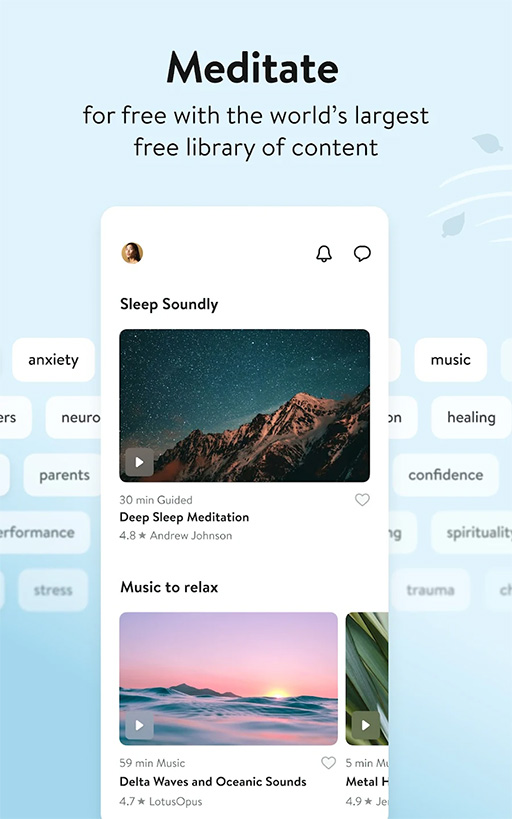
Best for: Kids with some meditation experience
Platforms: iOS, Android, and web
Cost: Free
Insight Timer offers a customizable meditation experience for your tween or teen. It has almost 70,000 guided meditations which can be personalized by adding ambient sound to the background. Users can select meditations of different lengths and pick their own sound to ring them out of the session. There are even virtual, real-time meditation events where users can join others from around the world.
It also offers guided breathwork and yoga, both of which are great for mindfulness and overall mental health. And because sleep is so beneficial for your kid’s mood, they can also use Insight Timer’s sleep sounds and stories.
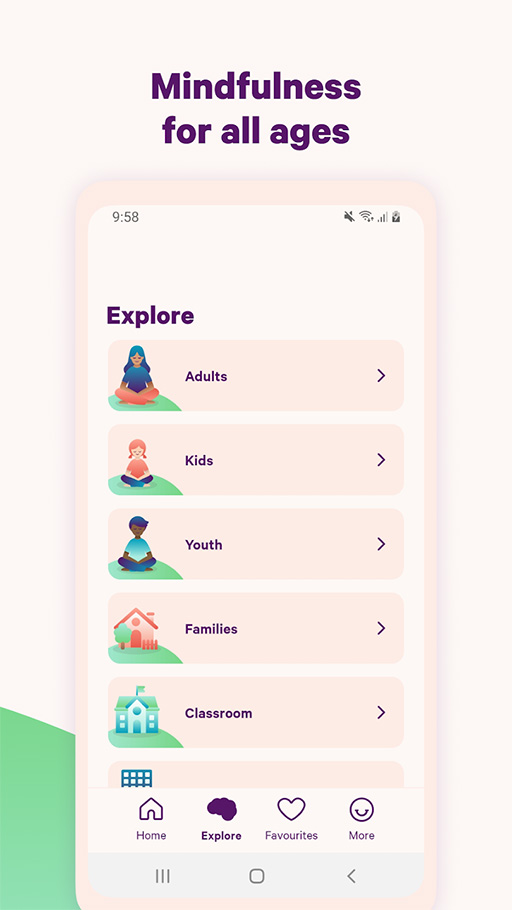
Best for: Stress, anxiety, general wellbeing, meditation, and mindfulness for all ages.
Platforms: iOS, Android
Cost: Free
Smiling Mind is an Australian meditation and mindfulness app designed by psychologists and educators. It has meditations geared for different ages and settings. Younger children can select the kids category, while tweens and teens will like the youth options. There’s even a section with meditations geared toward families. And the instructor’s Australian accents are an added bonus.
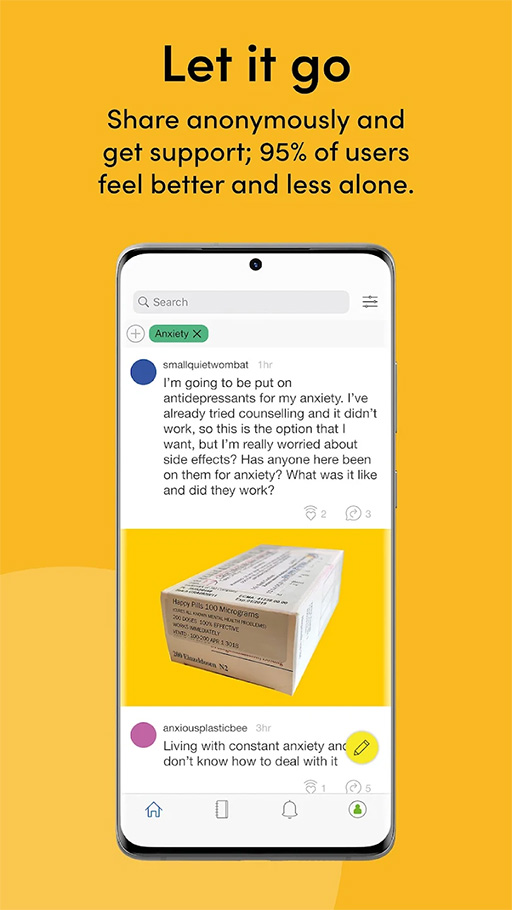
Best for: Stress, ADHD, depression, anxiety, grief, and sleep for ages 11-25.
Platforms: iOS, Android
Cost: Free
Tellmi is an anonymous peer support app for young people. Originally developed for the National Health System in the UK, it was proven effective through an independent study by University College London.
Users can share their experiences and get peer support. Plus, users are grouped by age, so you know your kids are only messaging with their peers. All chats are monitored by real humans and vetted before being posted. And in-house counselors are available to step in if there’s an issue that requires professional support.
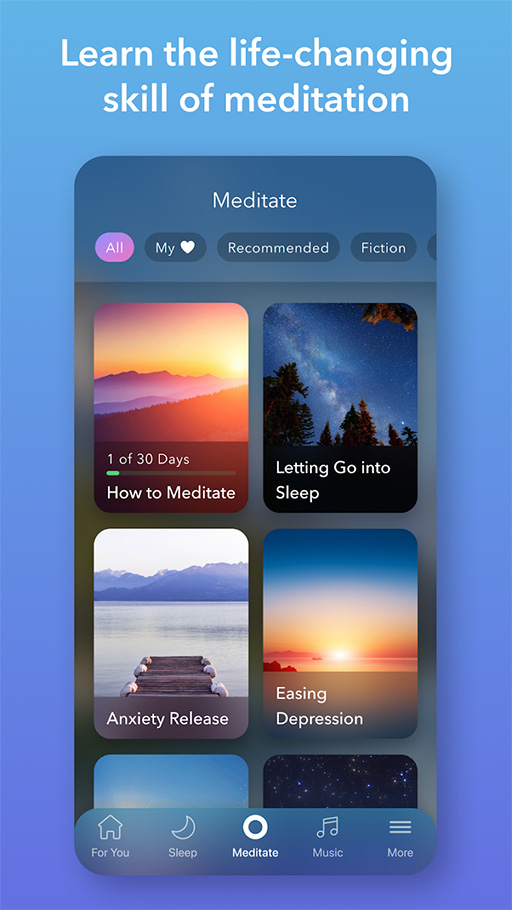
Best for: Everyday stress, anxiety, sleep issues, and mindfulness for all ages.
Platforms: iOS, Android, web
Cost: $69.99/year or $399.99/lifetime (after a 7-day free trial)
Calm is an award-winning app designed to help with stress, anxiety, sleep, and focus. It offers a suite of tools including mindful movement lessons, music to help with focus, and expert-led classes on a variety of topics from meditation to stress management.
Because consistency is key in developing new habits, your child can set up notifications to help remind them to meditate and stay on track. Users can select their current mood to receive a personalized plan for the day.
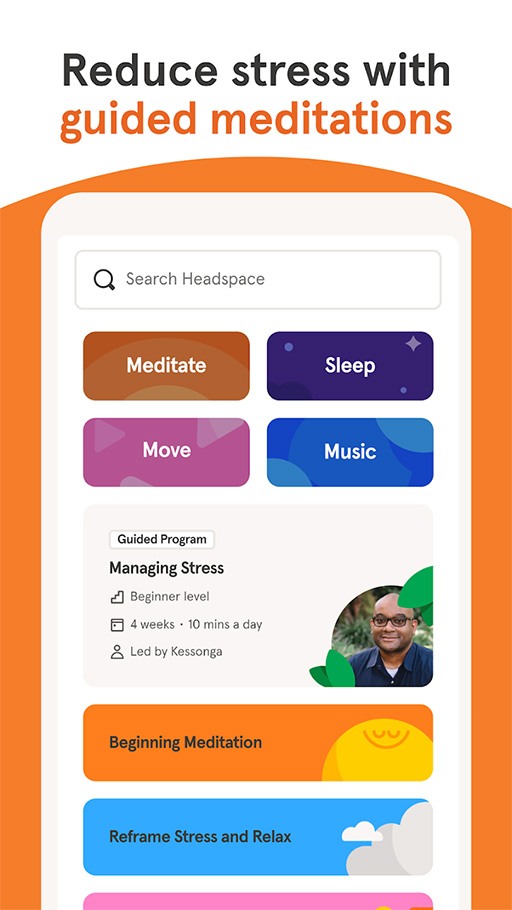
Best for: Guided meditation, mindfulness, stress, anxiety, and sleep for all ages
Platforms: iOS, Android
Cost: $69.99/year (after a 14-day free trial) or $12.99/month (after a 7-day free trial trial)
Headspace was one of the first meditation apps to splash onto the scene, and its popularity has held ever since. Since its inception, Headspace has expanded from guided meditation to include a variety of other resources, including short videos on topics like loneliness and stress and soundscapes to help with sleep.
All the meditations are led by experienced instructors and are relatively short (most are between 10-20 minutes), which is great for the teenage attention span! Your kid can also elect to get meditation reminders and daily words of wisdom.
Mindfulness, meditation, and mental health apps can help teach your child important coping skills to manage their stress, anxiety, and even difficulty sleeping. As with any app, it’s important to talk to your child about how to use it. It may even be helpful to try a few mindfulness exercises together — after all, we could all use a little less stress in our lives.

Summer’s here, and if you’re like me, you’ve resolved to use this time to finally set up a chore and allowance routine that sticks. Or perhaps you’re just sick of staring at the shapeless blob of teenage limbs permanently adhered to your couch. Whatever your motivation, it’s time to ditch the paper chore chart and explore the many digital tools available. Read on for our collection of the best apps for managing chores and allowances this summer and beyond.
Because we know every family is different, apps were selected based on their flexibility and the ability to customize them to meet your family’s needs. We looked for options that were easy to use and included robust features. User ratings were also taken into consideration to make sure our choices passed the real-world test.
Plans range between $4.99-14.98/month (one-month free trial)
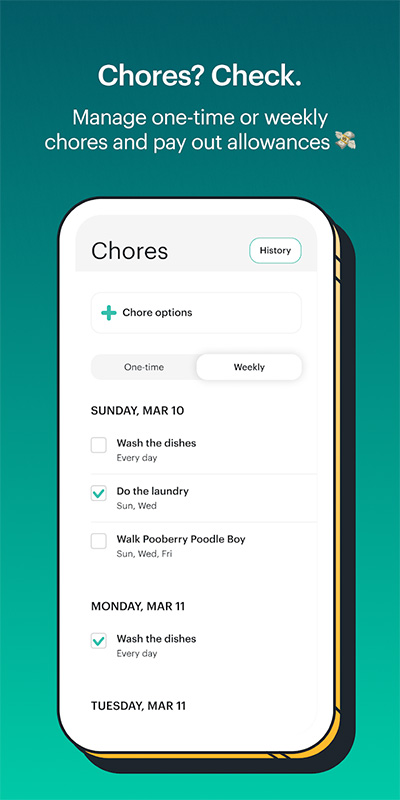
Greenlight is an all-in-one banking and chore-management app that helps kids learn financial literacy skills while earning money for completing chores. It’s highly rated across all device platforms and has three subscription tiers, so you can choose the plan that best fits your family’s needs.
With Greenlight’s robust parental controls, you can choose if you want to tie allowance to chores and set up partial payment for partially completed tasks. Greenlight has a lot of the same chore management options as other apps, but where it really shines is its financial education component.
Because Greenlight is also a banking app, you can get a debit card for your kid so they can learn money management. Depending on the subscription level, kids can also earn between 1-5% cash back deposited into their savings account (cha-ching!). With investment options, money-literacy games, and flexible savings goals, your child will be earning financial wisdom alongside their money. And because it’s linked to your bank account, you can scratch ATM visits off your to-do list.
$2.99 (one-time charge)
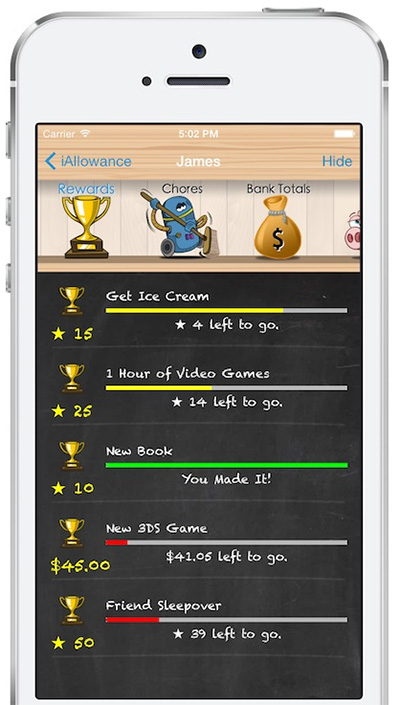
iAllowance is a no-frills app that sticks to its lane and does it well. It allows for plenty of flexibility so you can customize your child’s chore and allowance plan for maximum success.
This app is a great choice for families who don’t want to connect a bank account to their allowance app. With buckets for spend, save, and charity, your kids can set goals and watch their money grow.
If your family prefers to keep allowance and chores separate, you can set up alternative rewards such as stars or extra screen time. Rewards can be allocated by amount or percentage, and chores can be set up on daily, weekly, monthly, and yearly intervals. A full slate of preloaded chores will get you started with ideas, or you can add your own custom options.
Standard plan: free
Premium plan: $4.99/month (free trial for 45 days or 450 completed chores, whichever comes first)
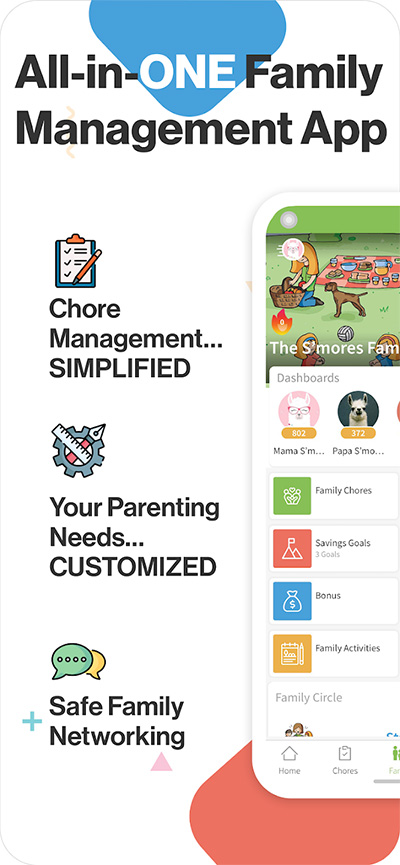
S’moresUp goes beyond chores and allowance with a variety of household management tools. It refers to itself as the “Swiss Army knife of parenting” and sets out to make your life easier, from scheduling and chores to allowance and family communication.
S’moresUp is a highly customizable app with an emphasis on collaboration between family members. Chore reminders, chore scheduling, and a shared family calendar will get you organized in no time. Kids earn “S’mores” for completing chores and can cash them out for money or other flexible rewards. The ability to post messages and photos will keep the whole family on the same page. You can also require photo proof that a task has been completed, so you don’t have to check when you arrive home.
Basic plan: free
Premium plan: $19.99/year (7 day free trial)
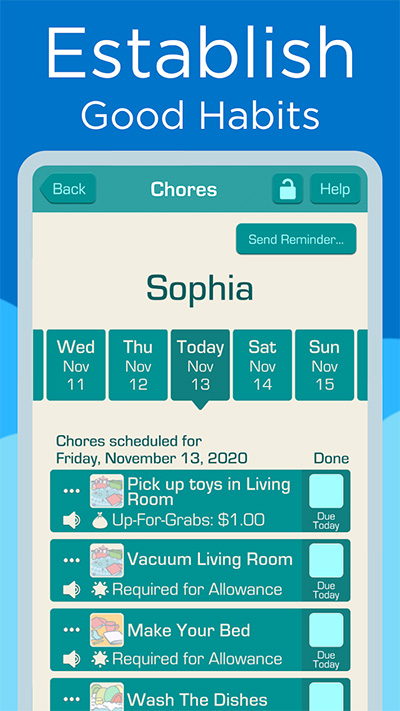
Chores & Allowance Bot is another highly rated, customizable app that allows for maximum flexibility. And there’s a web version, making it ideal if your kids don’t have devices yet.
You can rotate chores between kids and even set up-for-grabs chores for motivated kids. It also includes features like partial allowance for partial chore completion, customizable savings goals, and chores reminders. Chores can be set on a one-time, daily, weekly, or monthly basis. And while it doesn’t require linking to a bank account, it does have a detailed ledger of transactions so you can help your kids see their progress and track their goals.
Establishing a routine for chores and allowance can feel daunting as parents. But by utilizing an app to help you manage things, you can have an effective system set up in no time.

From flat-earthers, to QAnon, to PizzaGate, and even the Titanic, the internet is rife with conspiracy theories — and teens are particularly susceptible to them. Read on for more information on conspiracy theories in the digital era, along with tips on talking about them with your kids.
Conspiracy theories pop up everywhere, but they have particularly problematic histories on YouTube and TikTok. This is a challenge given how much time tweens and teens spend on social media — often several hours a day. There’s also concern among some researchers about the role gaming platforms can play in spreading misinformation and conspiracy theories.
“On social media, repetition substitutes for validation,” Russel Muirhead, a Dartmouth College professor and co-author of “A Lot of People Are Saying: The New Conspiracism and the Assault on Democracy” told Wired in 2020. “Repetition is what breathes air into conspiracy theories, and social media is all about repetition.”
Several studies have shown 14-18 year-olds to be especially susceptible to conspiratorial thinking. The teenage years are a time when kids are looking for community and seeking significance — both of which some people find in conspiracy theories. Add this to teenagers’ still-emerging critical thinking skills, and you have the perfect breeding ground for falling prey to conspiracies. Disinformation campaigns and unmonitored algorithms take advantage of this and often directly seek out younger users on these platforms to steer them toward more misleading content.
Here are a few things that may indicate your child is engaging with conspiracy theories:
A recent study examining the relationship between social media and conspiracy theories found that the more likely a person is to believe conspiracy theories, the more social media influences their thinking. So, preventing your child from believing in conspiracy theories in general is the best way to prevent them from falling down social media conspiracy theory rabbit holes.
Here are a few actions you can take to help prevent your child from adopting a conspiracy mindset in the first place:
Allow your child to share their beliefs without fear of judgment or ridicule. Rather than scolding them for differing beliefs, encourage them to explain how their opinion was formed and then respectfully introduce other possibilities. The more they feel comfortable sharing their beliefs with you, the more of a role you can play in steering them away from conspiracy theories.
Simply telling your children what to think teaches them to blindly accept what they’re told. This lack of questioning may open them up to conspiracy theories. Instead, explain why you believe what you do and how you formed those beliefs. Ask them what they think and be open if they express opinions different from your own.
Promote evidence-based thinking with your children by showing them how to seek out credible sources. Talk through common conspiracy theories with your children to demonstrate how to spot them.
Periodic check-ins on your child’s digital activity, as well as monitoring tools, make it more likely you’ll spot a problem with conspiracy theories early so it can be promptly addressed.

As a parent, you can do everything possible — and your kid may still fall for a conspiracy theory. Fortunately, there are strategies you can take to help them.
The internet is full of conspiracy theories, and teens are particularly susceptible to them. With the right approach, you can decrease the chances of your child getting caught up in conspiracy theories and help them think critically if they do fall for one.

As if keeping up on your child’s online activity isn’t hard enough, many of social media’s youngest users turn to fake accounts (often called Finstas or Faketoks) to hide their activity.
Read on to learn how to tell if your child has a secret social media account and what to do about it.
Before you go into Nancy Drew sleuth mode, ask your child if they have secret social media accounts. Approach the conversation with curiosity rather than accusation — you’ll have better luck getting the truth that way.
If your child denies having secret accounts but you’re still concerned, it’s time to do some digging. Here are some things to look for:
This could be a sign they’re spending more time on another account.
Intentionally obscuring your view of their device, suddenly closing a browser, or setting their phone down when you come into the room are all signs your child might have something to hide.
Look through your kid’s friends’ accounts for pictures of your child tagged under a different account. (Of course, it’s entirely possible their friends also have fake accounts.)
Look at who your child follows on their main account as well as their followers. They probably follow their fake account, and you may be able to spot a username or profile pic that gives them away.
Both Instagram and TikTok allow users to manage multiple accounts from a single device. Simply tap their username at the top or bottom of the app. If they have multiple accounts, a dropdown menu of usernames will appear.
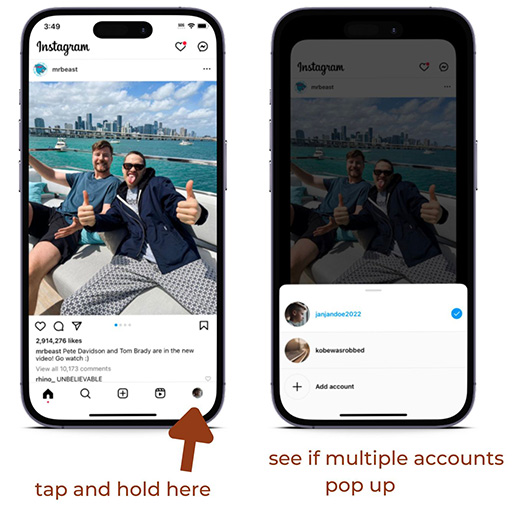
Remember, trust is a two-way street — it’s best to tell your child you need to look at their phone, rather than snooping.
While it’s natural to be upset when your child deceives you, it’s also developmentally appropriate for adolescents to occasionally try and hide things from their parents.
There are many reasons why kids create secret social media accounts. Some are cause for concern, like hiding risky or illegal behavior, but others are harmless, like posting silly videos or sharing vulnerable feelings they’re embarrassed to put on their real account.
Finstas and Faketoks are common with today’s adolescents. If you discover your child has a secret social media account, it’s important to address it with them in an open, respectful manner that addresses their underlying reasons for creating it and takes their age into account. Nobody likes feeling duped, but meeting your child where they’re at — and setting clear expectations about their online activity— can help reinforce the trust you share with your child.

You work to raise your child to be a kind, ethical person, and you want them to behave that way online, too. But let’s face it: the internet isn’t known for bringing out the best in people. You’ve seen the snarky comments, mean-spirited memes, and petty back-and-forths. You know how easy it would be for your kid to fall into that negativity trap. That’s why it’s important to teach kids not only how to safely navigate the digital world, but also the principles of digital citizenship.
Read on for tips on how to help your child live their values online and become a good digital citizen.
“Digital citizenship” means behaving responsibly online, just like you’d expect your kid to act in real life. As a parent, you can help your child understand that their actions have consequences online, and they’re talking to real people behind the screen.
After all, the anonymity of the internet means it’s easy to forget that a real person is (usually) behind the comments and posts your child sees on their screens. Responsible digital citizens are respectful, protect their privacy and their boundaries, and think critically about what they encounter online.
Guide your child to set intentions about their behavior. Here are some questions to frame the conversation:
In addition to helping your child articulate their own values, use this conversation to discuss your family’s shared values and how those apply to their actions online. Over the years, you’ve likely talked about what you expect from their behavior. Those conversations can be a helpful reference point now.
For example, you might remind them that inclusion is an important value in your family. Just as you expect them to include rather than exclude others in person, the same holds true on social media.
Help your child align their actions to their values by encouraging integrity and authenticity online. Come up with examples of scenarios they could face (such as witnessing cyberbullying) and discuss how they might handle them.
Every time her kids leave the house, a friend of mine reminds them, “Don’t be a jerk. Be a good friend.” I love this because it distills their family values into a bite-sized nugget of wisdom that’s easy to remember and can be referenced regularly.
Consider creating a motto with your child that encapsulates what it means to your family to be a good digital citizen. It could be as simple as “Think before you post,” or “Be as kind online as you are offline.”
If you want your child to behave a certain way online, it starts with what they see from you. Our kids learn by example: before you post or comment, consider how your kids would feel if they saw your comment. (If you have a public social media profile, odds are high that they will see it.)
If you run into a conflict online, model how you solve the problem with your child. For example, if someone leaves a hurtful comment on one of your posts, share how you handled it — did you impulsively reply with an aggressive comment of your own, or did you step away and report or delete the comment?
You probably know by now it’s important to keep an eye on your child online in order to protect their safety. It’s wise to adopt a similarly hands-on approach to ensure they’re being a good digital citizen.
Don’t worry, there’s no need to become a helicopter parent or spend all your free time on TikTok. Following your kid on social media, regularly sitting down with them to review their accounts, or using a service like BrightCanary are all great ways to keep tabs.
If you see something concerning, rather than jumping to punishment mode, have an honest conversation with your child about the situation. Remember, they’re still learning how to be good humans on the internet. Address the issue directly — but gently guide them back on course.
Your kid will mess up. They’re only human. Let them know they can always come to you with their problems and mistakes, and you’ll do your best to listen without judgment and support them through it.
By keeping your proverbial door open, your children are more likely to feel safe opening up to you when they do something online that’s outside of their values and your expectations. Using a values-focused lens, help them brainstorm ways to repair the situation and make amends.
The term IRL (in real life) implies that our online behavior somehow exists in a separate category from the rest of our life. In reality, what we do on the internet reflects on us both online and off.
It’s vital that we teach our children to live their values online. Take the time to help your child learn how to articulate their values, discuss how they can live those values on the internet, and be a resource as they learn to be a good digital citizen.

I see you, parents who carefully considered when to allow your child to get a phone and use social media. You weighed the pros and cons and came to a thoughtful conclusion.
You felt good about your decision until your kid came home and declared that everyone else has a phone and Instagram and TikTok, and now they’re left out of everything, and IT’S JUST NOT FAIR!
Read on for tips on standing firm, knowing when to compromise, and helping your child through their feelings.
Anytime kids say, “everyone else,” it’s worth remembering children are often prone to globalizing. Before you go into solution mode, take the time to get all the facts.
Ask your child to be specific about who has what access. Is it one or two friends that have a Snapchat, or are they literally the only one in their friend group without a phone and social media accounts?
As you listen, try to put yourself in their shoes. Think back to when you were young. Feeling left out is a legitimately difficult experience. Empathizing with your child doesn’t mean you need to give in, but it will help them feel heard — which goes a long way.
Provide a clear explanation for why you don’t think they’re ready for the digital access they’re requesting. If relevant, connect it to your family’s shared values.
Let them know when they will be allowed. If your benchmark isn’t something tangible, like age, be as specific as possible about what needs to happen for you to get to yes.
For example, maybe your child will be ready for a phone when they show they can be responsible in other areas of their life. Explain that you understand they want a phone, but first, they need to consistently take care of their chores around the house and complete those missing homework assignments.
Be clear about your timeline for follow-up: let your child know that you can revisit the topic in a month, after they’ve had time to show how responsible they can be.
Once you have a handle on what your child hopes to gain from more digital privileges, work with them to come up with alternative ways to meet those needs. Here are a few ideas to get you started:
Facebook’s messaging app for kids allows for a high level of parental control. It’s a great tool for kids to chat with family and friends in a safe, supervised way.
Consider giving your number to a few of your child’s close friends so they can correspond with them through your device.
Setting up a shared account with your child that you sit down and use together gives them some access, while allowing you the chance to coach them on responsible social media use. (Psst: This is a great way to introduce a parental monitoring tool like BrightCanary, which you can use to monitor their YouTube, Instagram, and TikTok activity.)
A family tablet or phone with parental controls is another option. Your child can message friends and use it to access authorized apps. Think of it as the modern equivalent of calling their friends on the house landline.
Make sure your child has plenty of opportunities to socialize and connect with friends offline. It’s easy for your child to feel left out when all their conversations happen in group messages, but hanging out with their friends in real life helps minimize that FOMO (fear of missing out). Consider hosting movie nights, game nights, or coordinating a larger group hangout with the other parents.
Occasionally revisit your decision about digital access to determine if you still feel the same way. If you do decide your opinion has changed, don’t get caught up in sticking to your guns just for the sake of not giving in.
While maintaining firm boundaries is important as a parent, you’re also allowed to change your mind. As long as you explain your reasons to your child and make it clear you’ve carefully considered your decision, it will be clear you’re not just bowing to their demands.
It’s difficult when your child’s friends have more digital access than they do. It can cause them to feel left out and to miss opportunities for socialization. This won’t be the last time that your kid feels left out or has the urge to keep up with the Joneses. Use this as an opportunity to help them build resiliency, understand your boundaries, and find a compromise together.
There’s no one-size-fits-all answer to address the issue. But with open communication and creative brainstorming, you can find a plan that everyone can — if not love — then at least live with.